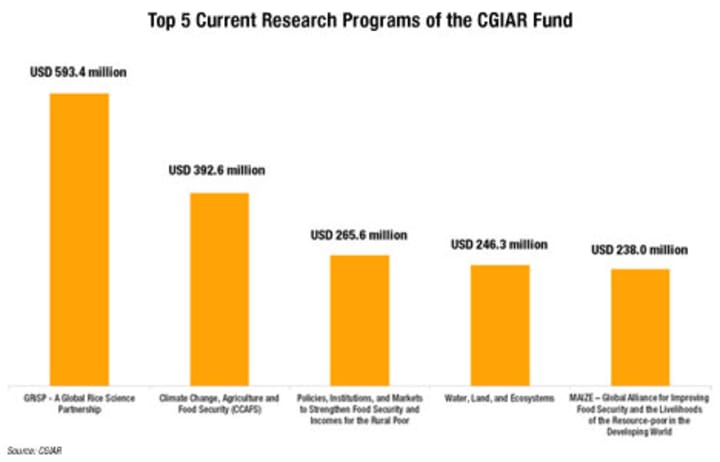
Innovation and cutting-edge research continue to be critical components of fostering agricultural productivity and food security. In his foundation’s 2012 annual letter released last January, global philanthropist Bill Gates contended that more resources should be allocated to agricultural research because it is one effective tool to counter ongoing food insecurity across the globe. The World Bank has stated publicly that investments in the agriculture sector actually have the greatest and most sustainable development impact. Recent events, including the Horn of Africa famine that began in July 2011, illustrate the humanitarian significance of agricultural research.
The Consultative Group on International Agricultural Research is playing an important role in this area. Established in 1971, CGIAR remains a principal agricultural research center that is constantly evolving and building partnerships to meet the demands of the global agricultural industry. The following summarizes the funding flows of CGIAR’s top research programs (as of Dec. 12, 2011), which are being implemented in partnership with various donors, local and national governments, nongovernmental organizations, the private sector, and other research institutes.
Global Rice Science Partnership
GRiSP is a rice research program led by the International Rice Research Institute. Approved in 2010 with a budget of nearly $594 million, the rationale behind the program is to reintroduce rice research and, for the first time, formally establish a single strategic work plan to support it. one unique feature of GRiSP is its emphasis on research that takes into account climate change, and population and health issues, which are not normally assessed as key factors. One of its goals is to reduce rice expenditures by almost $5 billion annually for those who are living under the poverty line (less than $1.25 a day) by 2020.
Climate Change, Agriculture and Food Security
Unlike GRiSP which focuses solely on rice research, CCAFS is a research program that covers a broader list of crops. It is a five-year project focused on integrating climate change adaptation and environmentally friendly measures into agricultural practices to ensure food security. The program’s goal is to identify and develop inexpensive eco-friendly agricultural technology that can benefit poor farmers. A research program with a $392.6 million budget, CCAFS’ implementation is led by the Centro Internacional de Agricultural Tropical.
Policies, Institutions, and Markets to Strengthen Food Security and Incomes for the Rural Poor Water, Land and Ecosystems
The program, under the International Food Policy Research Institute, aims to improve market access and utilization for poor farmers through policy and institutional analysis. Realizing that there is a difference between farming productivity and marketability (i.e. efficient crop production and actual crop selling), the program helps decision-makers identify and craft the necessary policies and institutional frameworks that will allow farmers to effectively tap markets and make a profit. With a budget close to $266 million, the program was approved in 2011.
Water, Land and Ecosystems
Currently administered by the International Water Management Institute, the three-year program, which is similar to CCAFS, tackles the importance between agricultural productivity and environmental protection. A population of 7 billion will rapidly deplete the world’s food sources which can have severe consequences for the environment. With a $246.3 million funding that was approved in 2011, the program aims to help agricultural activities yield profit and at the same time contribute to the preservation of land and water ecosystems.
MAIZE – Global Alliance for Improving Food Security and the Livelihoods of the Resource-Poor in the Developing World
Just like a crop-specific programs in GRiSP, this initiative focuses on doubling the current global production of maize to most English-speaking countries. A food staple for more than 4.5 billion people in the developing world, maize will eventually become a scarce commodity if innovative farming mechanisms are not adopted soon, according to experts. Currently managed by the International Maize and Wheat Improvement Center, or CIMMYT, with a $238 million funding, the program will develop sustainable, climate-resilient, maize-based farming systems in order to stabilize prices of such crops and improve overall production.
Read more:




